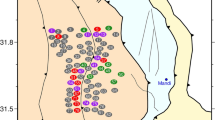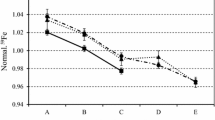Abstract
Ground and airborne gamma ray spectrometers are routinely used in uranium exploration for search of deposits and lithological mapping. These systems are calibrated using standard concrete calibration pads which are constructed with known concentrations of K, U and Th and simulate the infinite source geometry for gamma ray survey instruments. In India Atomic Minerals Directorate for Exploration and Research, a constituent of Department of Atomic Energy created such calibration facility at Nagpur civil Airport in 1984 and maintained it till date. The cost of maintaining these old pads is very high, therefore we have constructed new transportable calibration pads which are much smaller in size (1m x 1m x 30cm) and also transportable to field areas. Five pads namely Background pad, potassium pad, uranium pad, thorium pad and composite pad have been constructed. These are made of concrete spiked with pre determined concentrations of radio-elements uranium, thorium and potassium. These transportable calibration pads are 750kg in weight and are mounted on a trolley. This has eliminated the need for large standard calibration pads, which needed an airport with very high land leasing costs and thereby reducing the maintenance cost significantly. A very distinctive feature of designed transportable pads as compared to pads worldwide, is the achievement of high density and high compressive strength. This high density has resulted in higher sensitivity thereby improving the statistical accuracy of calibration. This has also resulted in reducing the fluctuations in calibration due to moisture in field condition. Another distinctive feature is the achievement of higher potassium concentration > 8.0% in potassium pad. Creation of this new calibration facility has resulted in substantial savings to government exchequer by eliminating the need of the airport. This has enabled calibration in the field areas with easy transportability and thereby reducing the downtime of the survey operations in uranium exploration. This paper describes the design and fabrication of transportable calibration pads in India.
Similar content being viewed by others

References
IAEA (1976) International Atomic Energy Agency, Radiometric Reporting Methods and Calibration in Uranium Exploration, Technical Reports Series No. 174, Vienna.
IAEA (1974) International Atomic Energy Agency, Recommended Instrumentation For Uranium And Thorium Exploration, Technical Reports Series No. 158, Vienna.
IAEA (1990) International Atomic Energy Agency, The use of Gamma Ray Data to Define the Natural Radiation Environment, Iaea-Tecdoc-566. Vienna.
IAEA (1979) International Atomic Energy Agency, Gamma Ray Surveys in Uranium Exploration, Technical Reports Series No. 186, Vienna.
Løvborg, L. (1984) The Calibration of Portable and Airborne Gamma Ray Spectrometers—Theory, Problems and Facilities, Rep. Risø-M-2456. Riso, Roskilde.
IAEA (1989) International Atomic Energy Agency, Construction And Use Of Calibration Facilities For Radiometric Field Equipment, Technical Reports Series No. 309, Vienna.
IAEA (2003) International Atomic Energy Agency, Guidelines for Radioelement Mapping Using Gamma Ray Spectrometry Data, Iaea-Tecdoc-1363.
Vienna. Grasty, R.L., Minty B.R.S. (1995) A guide to the Technical Specifications for Airborne Gamma”Ray Surveys. Australian Geological Survey Organization Record 1995/60.
Jadhav, J.G., Atal, B.S., Lal, Y. and Surange, P.G. (1988) Development of Facility for Calibration of Airborne and Portable Gamma Ray Spectrometer. Earfam, v. 1, pp.123–128.
Loveborg. L, Kirkgard, P and John Rosehansen, (1972) Quantitative Interpretation of the gamma ray spectra from geologic formations, Natural Rradiation Environment II, John A.S. Adams and Lowder pp.155–180.
Minty, B.R.S., Morse, M.P. and Richardson, L.M. (1990) Portable Calibration Sources for Airborne Gamma Ray Spectrometers. Exploration Geophysics, v. 21, pp. 187–195.
Minty, B.R.S. (1997) Fundamentals of Airborne Gamma Ray Spectrometry. Agso Jour. Australian Geol. Geophys., v. 17(2), pp.39–50.
Minty, B., Luyendyk, A., Brodie, R. (1997) Calibration and data processing for Airborne Gamma Ray Spectrometry. Agso Jour. Australian Geol. Geophys., v. 17(2), pp.51–62.
Ramayya M.S., Chaturvedi A.K., Parihar P.S., Sharma P.K. Jiwane D.U., Srivastava P.K. and Sunil T.C. (2018), Calibration of AGRS System using Transportable Pads in India: An application to AGRS data of Aevalli Basin, Banswada Block, South Rajasthan. Jour. Geol. Soc. India, v.91, pp.535–540.
Author information
Authors and Affiliations
Corresponding author
Rights and permissions
About this article
Cite this article
Sharma, P.K., Johri, N.K., Raut, G.B. et al. Construction and Characterization of Transportable Calibration Pads for Calibration of Portable and Airborne Gamma Ray Spectrometers in India. J Geol Soc India 92, 281–285 (2018). https://doi.org/10.1007/s12594-018-1005-8
Received:
Accepted:
Published:
Issue Date:
DOI: https://doi.org/10.1007/s12594-018-1005-8



